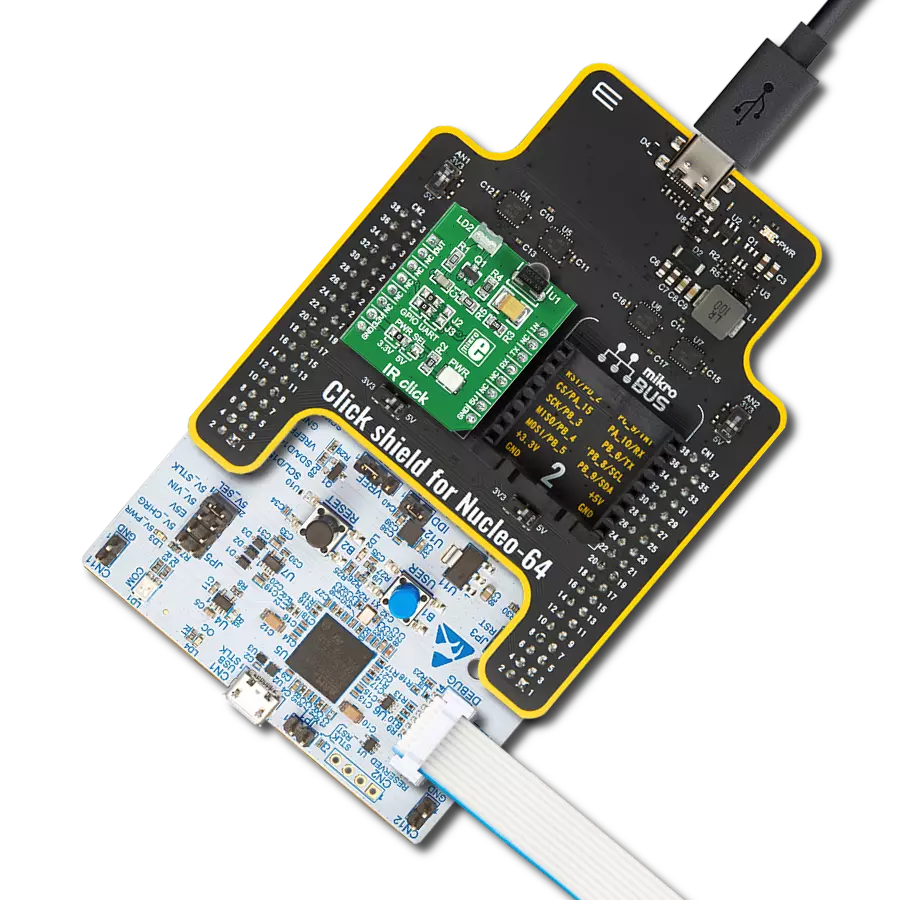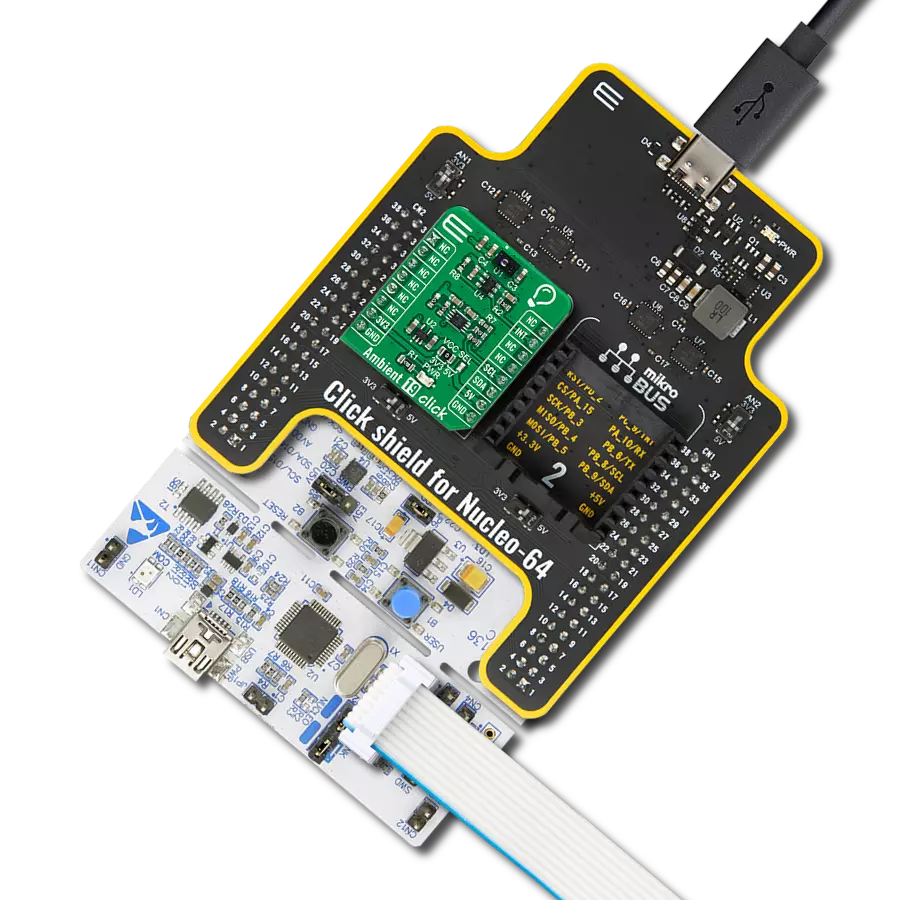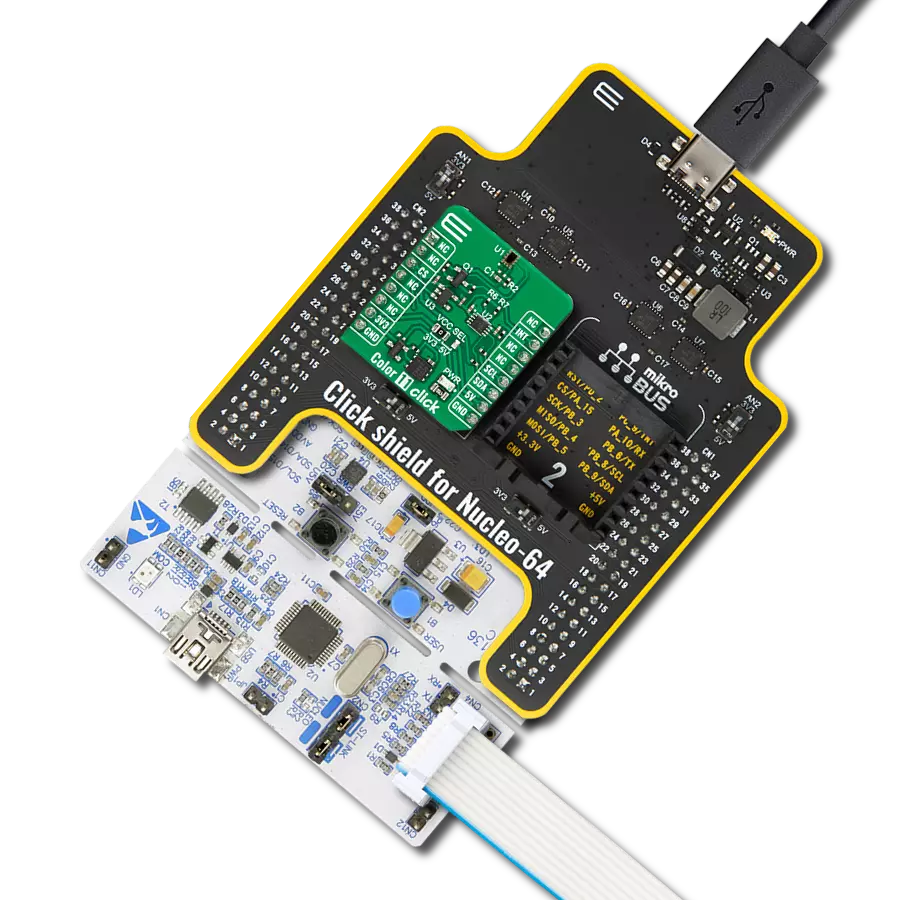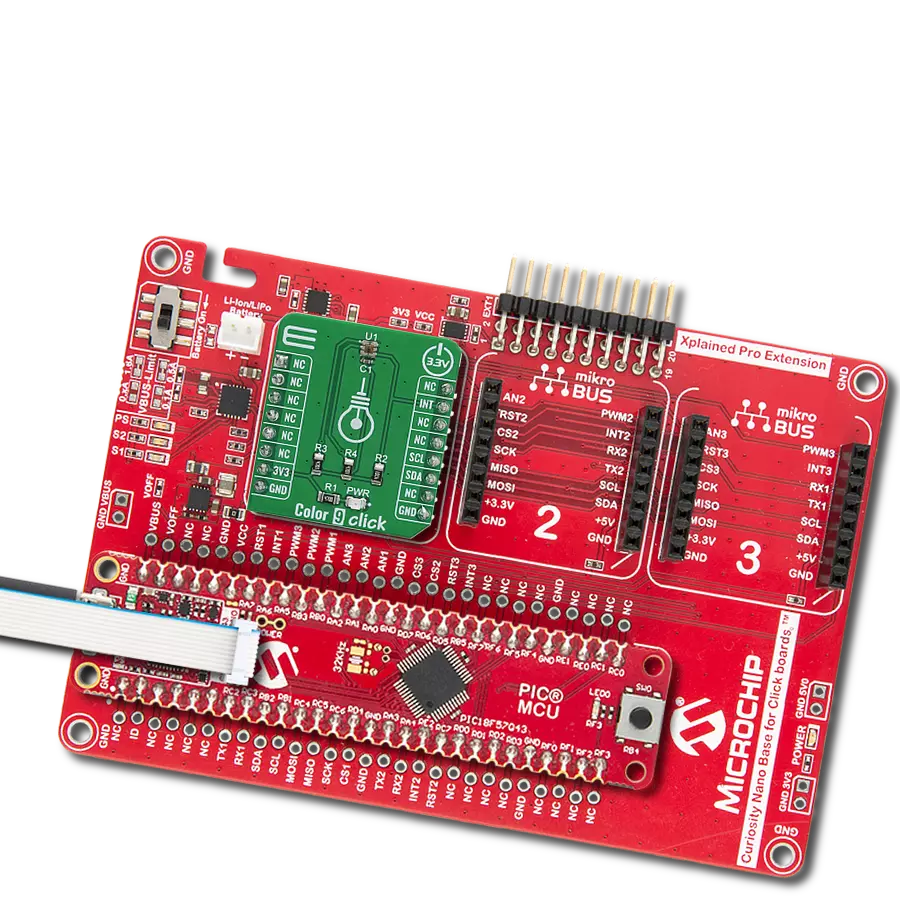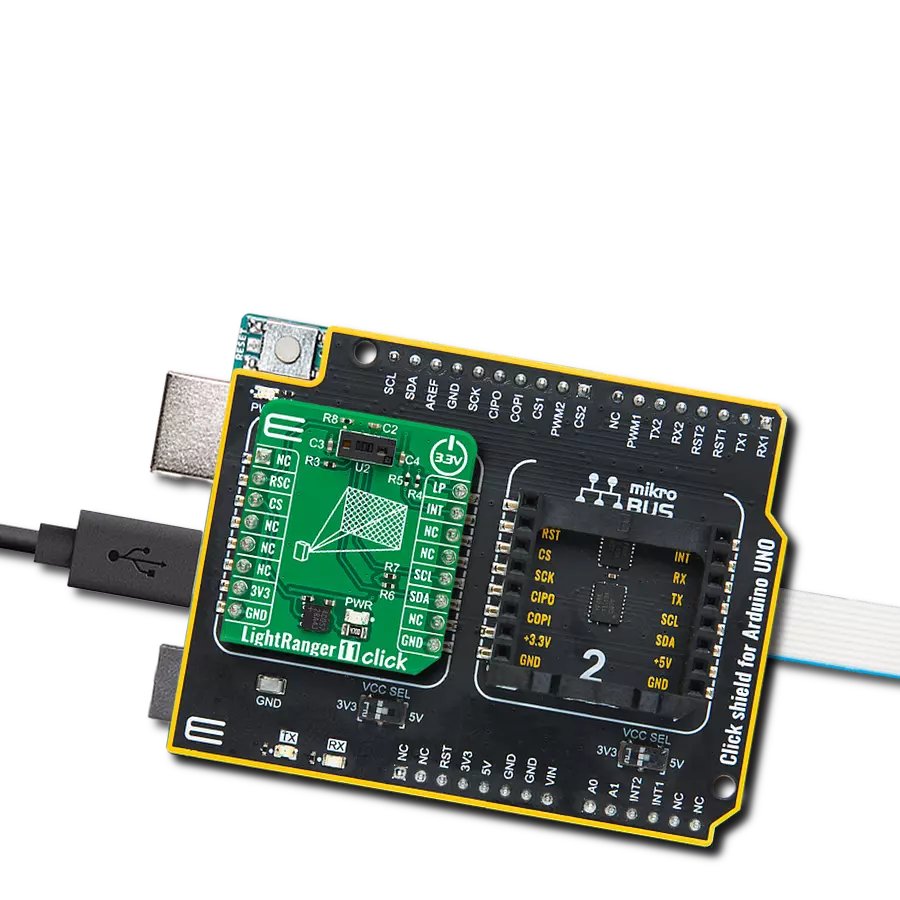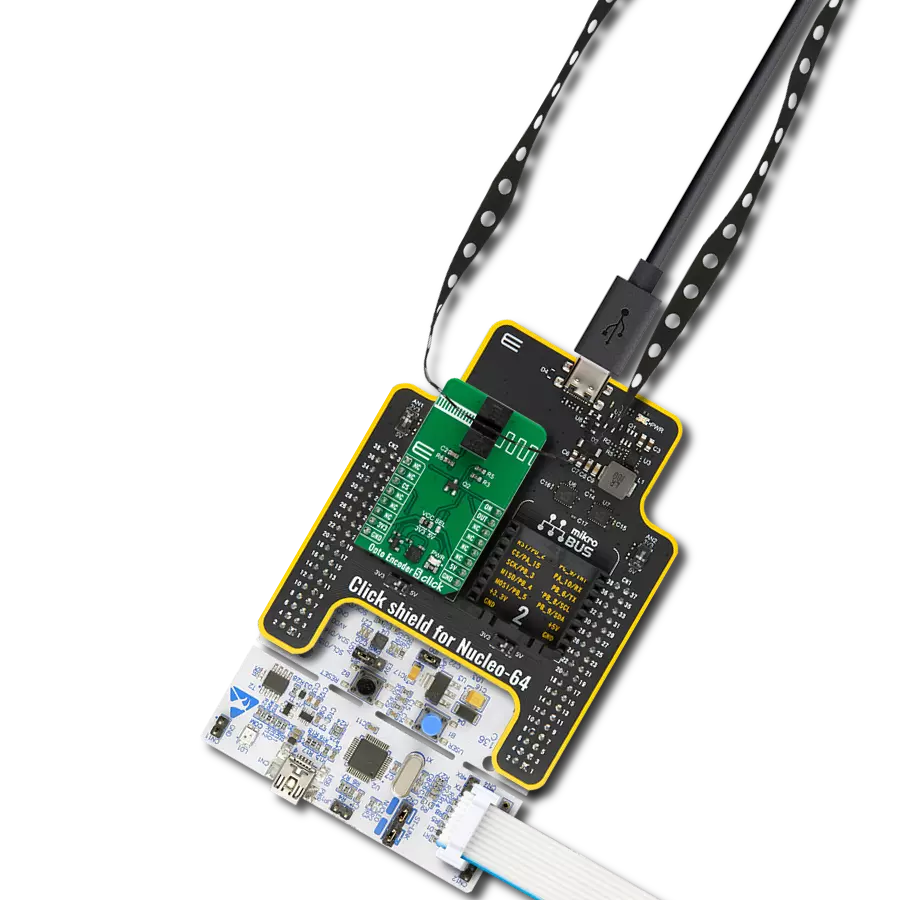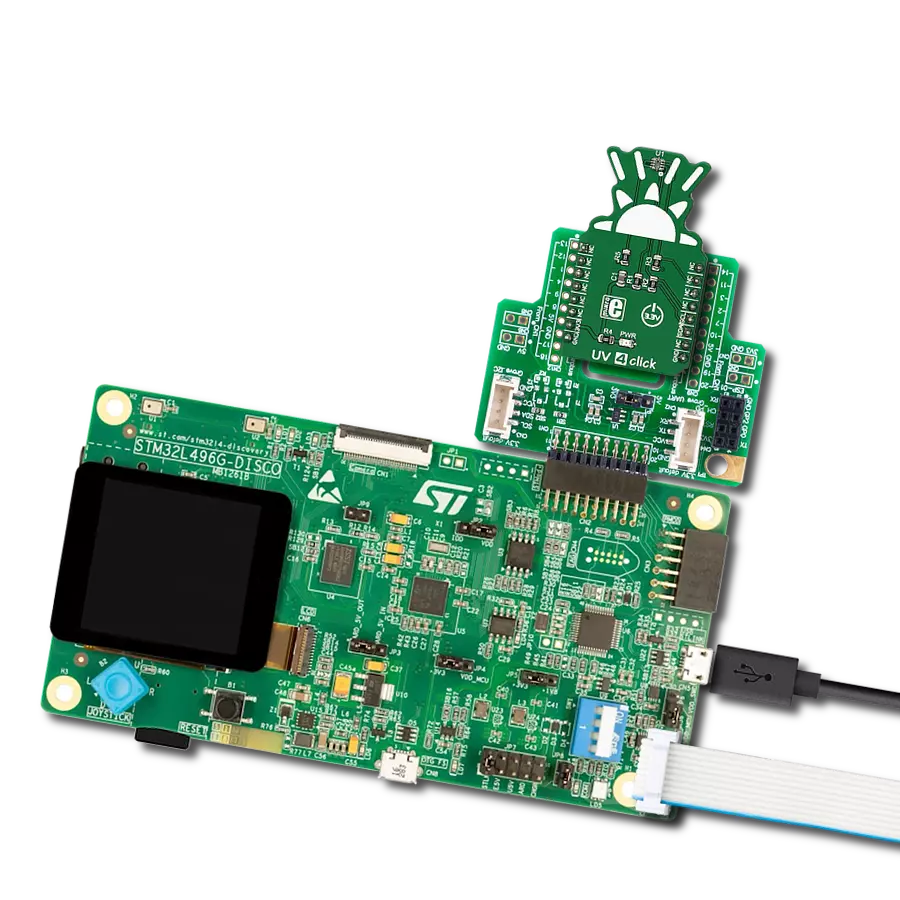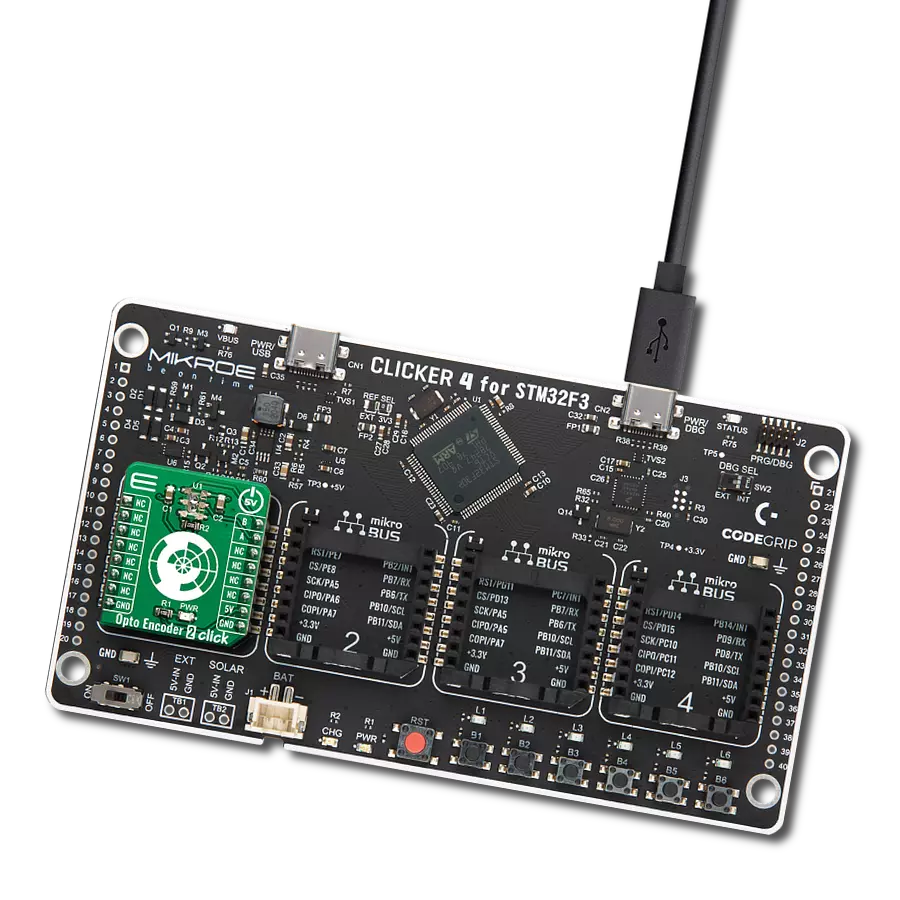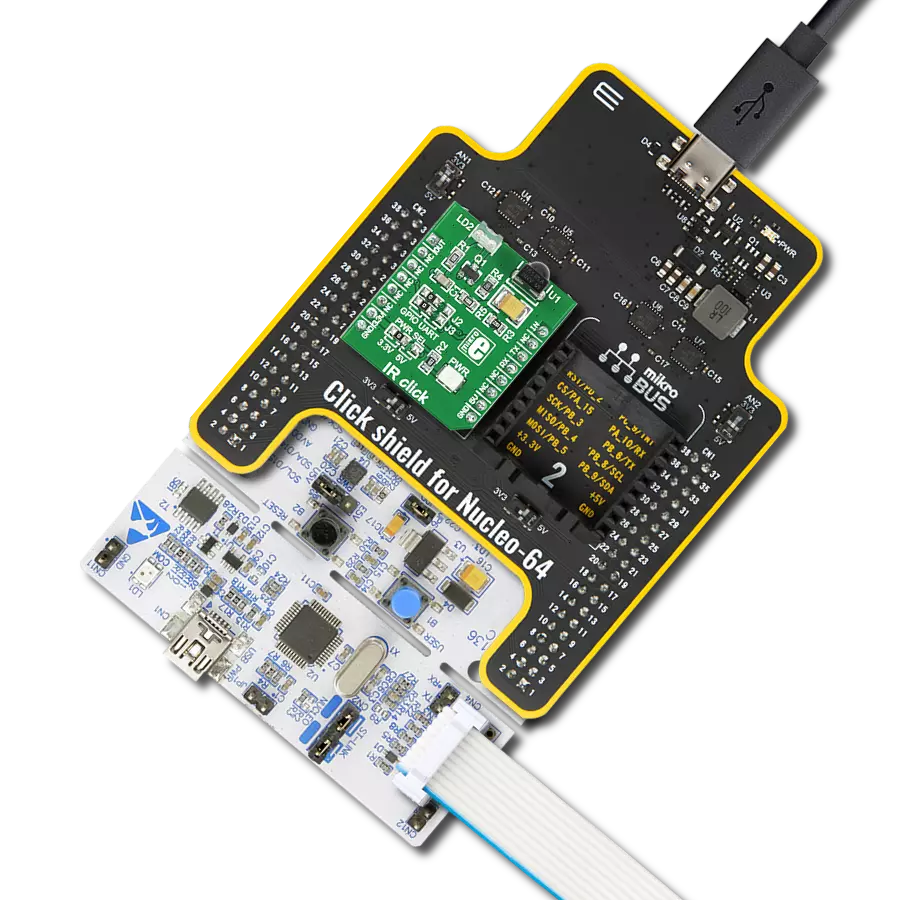Unlock the power of bi-directional IR communication for seamless data exchange and command execution between devices
A
A
Hardware Overview
How does it work?
IrDA 3 Click is based on the TFDU4101, an infrared transceiver module from Vishay compliant to the latest IrDA® physical layer standard. It supports IrDA speeds up to 115.2 Kbps. The transceiver module is composed of the IRED (infrared emitter) and the photodiode IR receiver, which is used to both emit and receive the IR light commands. The range of this device is more than 1m and it depends on several factors. To ensure maximum possible range, the power supply is decoupled with proper capacitors, also the used oscillator is very stable and accurate, resulting with the range of about 4m. The second IC device is the MCP2122, an infrared half duplex encoder/decoder from Microchip that takes care of the proper conversion of the UART signals to TFDU4101 acceptable IrDA
standard compliant data format. The MCP2122 has its UART interface pins routed to the mikroBUS™, and IrDA interface pins routed to the TFDU4101 IrDA module. The maximum communication speed for the UART interface is determined by the onboard oscillator that works at 1.8432MHz. The MCP2122 has the 16XCLK input that acts as a bit clock. The state of the bit is determined within 16 clock cycles of the 16XCLK input. This means that for every bit of the UART information, 16-bit clock cycles are needed - so the UART frequency is the bit clock frequency divided by 16, as shown by this formula: 1,843,200 / 16 = 115,200. At the same time, 115,200 is the maximum baud rate that can be used for the TFDU4101 IrDA transceiver. The click also has a voltage selection jumper for selecting
the voltage between 3.3V and 5V. Besides the UART RX and UART TX signals routed to the mikroBUS™, it also has the RESET signal routed to the RST pin of the mikroBUS™. The RESET pin is used to reset the MCP2122 device. The LOW logic state on this pin will reset the device, while the HIGH state is used for a normal operation. The device can be put in a low power state if the RST pin is held LOW. This Click board™ can operate with either 3.3V or 5V logic voltage levels selected via the PWR SEL jumper. This way, both 3.3V and 5V capable MCUs can use the communication lines properly. Also, this Click board™ comes equipped with a library containing easy-to-use functions and an example code that can be used as a reference for further development.
Features overview
Development board
Nucleo-64 with STM32F091RC MCU offers a cost-effective and adaptable platform for developers to explore new ideas and prototype their designs. This board harnesses the versatility of the STM32 microcontroller, enabling users to select the optimal balance of performance and power consumption for their projects. It accommodates the STM32 microcontroller in the LQFP64 package and includes essential components such as a user LED, which doubles as an ARDUINO® signal, alongside user and reset push-buttons, and a 32.768kHz crystal oscillator for precise timing operations. Designed with expansion and flexibility in mind, the Nucleo-64 board features an ARDUINO® Uno V3 expansion connector and ST morpho extension pin
headers, granting complete access to the STM32's I/Os for comprehensive project integration. Power supply options are adaptable, supporting ST-LINK USB VBUS or external power sources, ensuring adaptability in various development environments. The board also has an on-board ST-LINK debugger/programmer with USB re-enumeration capability, simplifying the programming and debugging process. Moreover, the board is designed to simplify advanced development with its external SMPS for efficient Vcore logic supply, support for USB Device full speed or USB SNK/UFP full speed, and built-in cryptographic features, enhancing both the power efficiency and security of projects. Additional connectivity is
provided through dedicated connectors for external SMPS experimentation, a USB connector for the ST-LINK, and a MIPI® debug connector, expanding the possibilities for hardware interfacing and experimentation. Developers will find extensive support through comprehensive free software libraries and examples, courtesy of the STM32Cube MCU Package. This, combined with compatibility with a wide array of Integrated Development Environments (IDEs), including IAR Embedded Workbench®, MDK-ARM, and STM32CubeIDE, ensures a smooth and efficient development experience, allowing users to fully leverage the capabilities of the Nucleo-64 board in their projects.
Microcontroller Overview
MCU Card / MCU
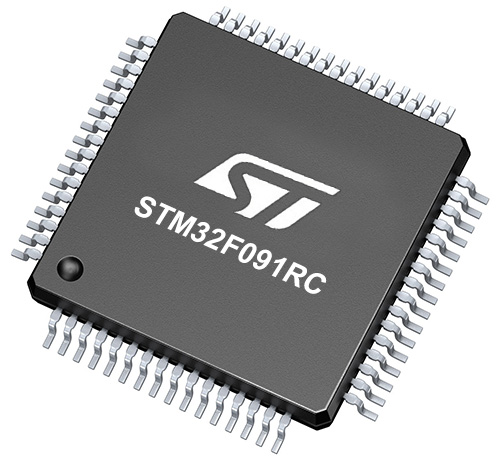
Architecture
ARM Cortex-M0
MCU Memory (KB)
256
Silicon Vendor
STMicroelectronics
Pin count
64
RAM (Bytes)
32768
You complete me!
Accessories
Click Shield for Nucleo-64 comes equipped with two proprietary mikroBUS™ sockets, allowing all the Click board™ devices to be interfaced with the STM32 Nucleo-64 board with no effort. This way, Mikroe allows its users to add any functionality from our ever-growing range of Click boards™, such as WiFi, GSM, GPS, Bluetooth, ZigBee, environmental sensors, LEDs, speech recognition, motor control, movement sensors, and many more. More than 1537 Click boards™, which can be stacked and integrated, are at your disposal. The STM32 Nucleo-64 boards are based on the microcontrollers in 64-pin packages, a 32-bit MCU with an ARM Cortex M4 processor operating at 84MHz, 512Kb Flash, and 96KB SRAM, divided into two regions where the top section represents the ST-Link/V2 debugger and programmer while the bottom section of the board is an actual development board. These boards are controlled and powered conveniently through a USB connection to program and efficiently debug the Nucleo-64 board out of the box, with an additional USB cable connected to the USB mini port on the board. Most of the STM32 microcontroller pins are brought to the IO pins on the left and right edge of the board, which are then connected to two existing mikroBUS™ sockets. This Click Shield also has several switches that perform functions such as selecting the logic levels of analog signals on mikroBUS™ sockets and selecting logic voltage levels of the mikroBUS™ sockets themselves. Besides, the user is offered the possibility of using any Click board™ with the help of existing bidirectional level-shifting voltage translators, regardless of whether the Click board™ operates at a 3.3V or 5V logic voltage level. Once you connect the STM32 Nucleo-64 board with our Click Shield for Nucleo-64, you can access hundreds of Click boards™, working with 3.3V or 5V logic voltage levels.
Used MCU Pins
mikroBUS™ mapper
Take a closer look
Click board™ Schematic

Step by step
Project assembly
Track your results in real time
Application Output
1. Application Output - In Debug mode, the 'Application Output' window enables real-time data monitoring, offering direct insight into execution results. Ensure proper data display by configuring the environment correctly using the provided tutorial.

2. UART Terminal - Use the UART Terminal to monitor data transmission via a USB to UART converter, allowing direct communication between the Click board™ and your development system. Configure the baud rate and other serial settings according to your project's requirements to ensure proper functionality. For step-by-step setup instructions, refer to the provided tutorial.

3. Plot Output - The Plot feature offers a powerful way to visualize real-time sensor data, enabling trend analysis, debugging, and comparison of multiple data points. To set it up correctly, follow the provided tutorial, which includes a step-by-step example of using the Plot feature to display Click board™ readings. To use the Plot feature in your code, use the function: plot(*insert_graph_name*, variable_name);. This is a general format, and it is up to the user to replace 'insert_graph_name' with the actual graph name and 'variable_name' with the parameter to be displayed.

Software Support
Library Description
This library contains API for IrDA 3 Click driver.
Key functions:
irda3_mode_setup- This function allows IrDA 3 click mode to be setirda3_pwr_setup- This function allows IrDA 3 click power mode to be setirda3_reset- This function executes a device reset operation.
Open Source
Code example
The complete application code and a ready-to-use project are available through the NECTO Studio Package Manager for direct installation in the NECTO Studio. The application code can also be found on the MIKROE GitHub account.
/*!
* @file main.c
* @brief IrDA 3 Click Example.
*
* # Description
* This example demonstrates the use of IrDA 3 Click boards.
* The example can perform both roles, transmitter and receiver.
*
* The demo application is composed of two sections :
*
* ## Application Init
* Initializes UART driver and all used control pins.
* Also clears the response buffer.
*
* ## Application Task
* Demonstrates the use of IrDA 3 Clicks which can be used as transmitter or
* receiver. There are four different examples in this project.
* Uncomment one of the below macros to select which example will be executed.
* By default the DEMO_APP_TRANSMITTER_1 example is selected.
*
* @author Jelena Milosavljevic
*
*/
// ------------------------------------------------------------------- INCLUDES
#include "board.h"
#include "log.h"
#include "irda3.h"
// ------------------------------------------------------------------ VARIABLES
#define PROCESS_BUFFER_SIZE 200
//#define DEMO_APP_RECEIVER_1
//#define DEMO_APP_RECEIVER_2
#define DEMO_APP_TRANSMITTER_1
// #define DEMO_APP_TRANSMITTER_2
static irda3_t irda3;
static log_t logger;
static char tx_message[ ] = { 'M', 'i', 'k', 'r', 'o', 'E', '\r', '\n', '\0' };
static char rx_message[ 10 ];
static uint8_t idx;
// ------------------------------------------------------ APPLICATION FUNCTIONS
void application_init( void ) {
irda3_cfg_t irda3_cfg;
log_cfg_t logger_cfg;
/**
* Logger initialization.
* Default baud rate: 115200
* Default log level: LOG_LEVEL_DEBUG
* @note If USB_UART_RX and USB_UART_TX
* are defined as HAL_PIN_NC, you will
* need to define them manually for log to work.
* See @b LOG_MAP_USB_UART macro definition for detailed explanation.
*/
LOG_MAP_USB_UART( logger_cfg );
log_init( &logger, &logger_cfg );
log_printf( &logger, "*** IrDA initialization done ***\r\n" );
log_printf( &logger, "**********************************\r\n" );
// Click initialization.
irda3_cfg_setup( &irda3_cfg );
IRDA3_MAP_MIKROBUS( irda3_cfg, MIKROBUS_1 );
irda3_init( &irda3, &irda3_cfg );
irda3_default_cfg( &irda3 );
irda3_reset( &irda3 );
// Clear response.
memset( rx_message, 0, sizeof( rx_message ) );
}
void application_task( void ) {
#ifdef DEMO_APP_RECEIVER_1
rx_message[ 0 ] = irda3_generic_single_receive( &irda3 );
if ( rx_message[ 0 ] != 0 ) {
log_printf( &logger, "%c", ( char ) rx_message[ 0 ] );
}
Delay_ms ( 100 );
#endif
#ifdef DEMO_APP_RECEIVER_2
irda3_generic_multiple_receive( &irda3, rx_message, '\n' );
log_printf( &logger, "RECEIVED MESSAGE : " );
log_printf( &logger, "%s\r\n", rx_message );
Delay_ms ( 100 );
#endif
#ifdef DEMO_APP_TRANSMITTER_1
irda3_generic_multiple_send( &irda3, tx_message );
log_printf( &logger, "MESSAGE SENT\r\n" );
Delay_ms ( 1000 );
Delay_ms ( 1000 );
#endif
#ifdef DEMO_APP_TRANSMITTER_2
idx = 0;
while ( tx_message[ idx ] != '\0' ) {
irda3_generic_single_send( &irda3, tx_message[ idx++ ] );
}
log_printf( &logger, "MESSAGE SENT\r\n" );
Delay_ms ( 1000 );
Delay_ms ( 1000 );
#endif
}
int main ( void )
{
/* Do not remove this line or clock might not be set correctly. */
#ifdef PREINIT_SUPPORTED
preinit();
#endif
application_init( );
for ( ; ; )
{
application_task( );
}
return 0;
}
// ------------------------------------------------------------------------ END
Additional Support
Resources
Category:Optical



















